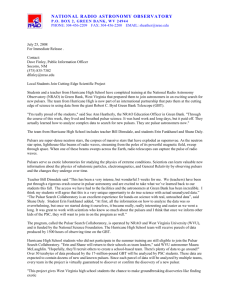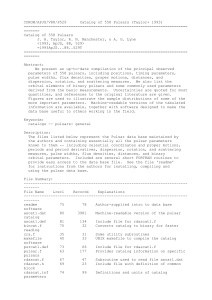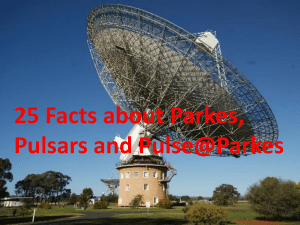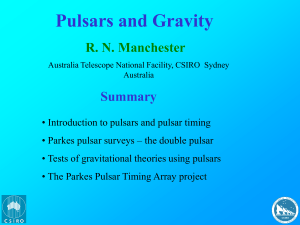PPT - ICRA
advertisement
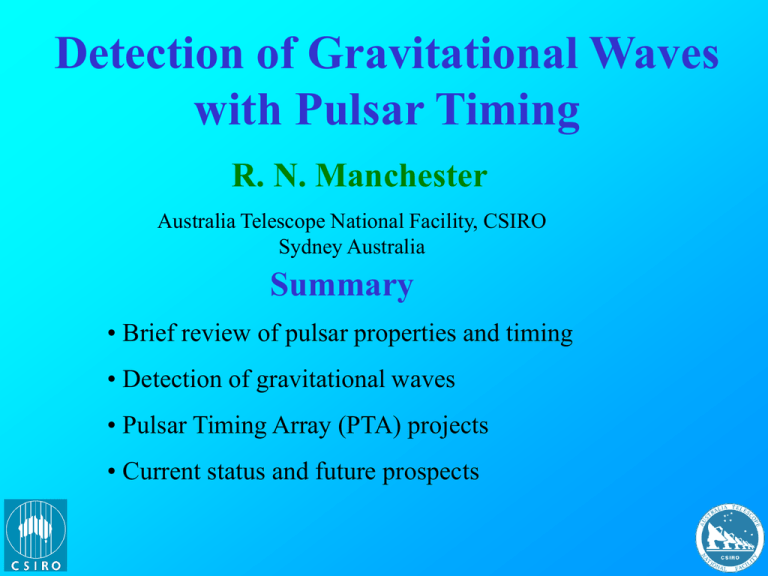
Detection of Gravitational Waves with Pulsar Timing R. N. Manchester Australia Telescope National Facility, CSIRO Sydney Australia Summary • Brief review of pulsar properties and timing • Detection of gravitational waves • Pulsar Timing Array (PTA) projects • Current status and future prospects Spin-Powered Pulsars: A Census • Currently1886 known (published) pulsars • 1674 rotation-powered disk pulsars • 179 in binary systems • 192 millisecond pulsars • 108 in globular clusters* • 13 AXP/SGR • 20 extra-galactic pulsars * Total known: 140 in 26 clusters (Paulo Freire’s web page) Data from ATNF Pulsar Catalogue, V1.36 (www.atnf.csiro.au/research/pulsar/psrcat; Manchester et al. 2005) Pulsar Origins Pulsars are believed to be rotating neutron stars – two main classes: Normal Pulsars: • Formed in supernova • Periods between 0.03 and 10 s • Relatively young (< 107 years) • Mostly single (non-binary) (ESO – VLT) Millisecond Pulsars (MSPs): • MSPs are very old (~109 years). • Mostly binary • They have been ‘recycled’ by accretion from an evolving binary companion. • This accretion spins up the neutron star to millisecond periods. • During the accretion phase the system may be detectable as an X-ray binary system. Pulsars as Clocks • Neutron stars are tiny (about 25 km across) but have a mass of about 1.4 times that of the Sun • They are incredibly dense and have gravity 1012 times as strong as that of the Earth • Because of this large mass and small radius, their spin rates and hence pulsar periods - are incredibly stable e.g., PSR J0437-4715 had a period of : 5.757451831072007 0.000000000000008 ms • Although pulsar periods are very stable, they are not constant. Pulsars lose energy and slow down • Typical slowdown rates are less than a microsecond per year . The P – P Diagram P = Pulsar period . P = dP/dt = slow-down rate . • For most pulsars P ~ 10-15 . • MSPs have P smaller by about 5 orders of magnitude • Most MSPs are binary, but few normal pulsars are . • P/(2P) is an indicator of pulsar age • Surface dipole magnetic field ~ (PP)1/2 . Great diversity in the pulsar population! Galactic Disk pulsars The First Binary Pulsar • Discovered at Arecibo Observatory by Russell Hulse & Joe Taylor in 1975 • Pulsar period 59 ms, a recycled pulsar • Doppler shift in observed period due to orbital motion • Orbital period only 7 hr 45 min • Maximum orbital velocity 0.1% of velocity of light Relativistic effects detectable! PSR B1913+16 Orbital Decay in PSR B1913+16 • Rapid orbital motion of two stars in PSR B1913+16 generates gravitational waves PSR B1913+16 Orbit Decay • Energy loss causes slow decrease of orbital period • Can predict rate of orbit decay from known orbital parameters and masses of the two stars using general relativity • Ratio of measured value to predicted value = 1.0013 0.0021 Confirmation of general relativity! First observational evidence for gravitational waves! (Weisberg & Taylor 2005) Detection of Gravitational Waves • Prediction of general relativity and other theories of gravity • Generated by acceleration of massive object(s) • Astrophysical sources: Inflation era fluctuations Cosmic strings BH formation in early Universe Binary black holes in galaxies Coalescing neutron-star binaries Compact X-ray binaries (K. Thorne, T. Carnahan, LISA Gallery) Detection of Gravitational Waves • Generated by acceleration of massive objects in Universe, e.g. binary black holes • Huge efforts over more than four decades to detect gravitational waves • Initial efforts used bar detectors pioneered by Weber • More recent efforts use laser interferometer systems, e.g., LIGO, VIRGO, LISA LIGO LISA • Two sites in USA • Perpendicular 4-km arms • Spectral range 10 – 500 Hz • Initial phase now operating • Advanced LIGO ~ 2014 • Orbits Sun, 20o behind the Earth • Three spacecraft in triangle • Arm length 5 million km • Spectral range 10-4 – 10-1 Hz • Planned launch ~2020 Limiting the GW Background with Pulsars • Observed pulsar periods are modulated by gravitational waves in Galaxy • With observations of just a few pulsars, can only put a limit on strength of the stochastic GW background • Best limits are obtained for GW frequencies ~ 1/T where T is length of data span • Analysis of 8-year sequence of Arecibo observations of PSR B1855+09 gives Wg = rGW/rc < 10-7 (Kaspi et al. 1994, McHugh et al.1996) Timing residuals for PSR B1855+09 A Pulsar Timing Array (PTA) • With observations of many pulsars widely distributed on the sky can in principle detect a stochastic gravitational wave background • Gravitational waves passing over the pulsars are uncorrelated • Gravitational waves passing over Earth produce a correlated signal in the TOA residuals for all pulsars • Requires observations of ~20 MSPs over 5 – 10 years; could give the first direct detection of gravitational waves! • A timing array can detect instabilities in terrestrial time standards – establish a pulsar timescale • Can improve knowledge of Solar system properties, e.g. masses and orbits of outer planets and asteroids Idea first discussed by Hellings & Downs (1983), Romani (1989) and Foster & Backer (1990) Clock errors All pulsars have the same TOA variations: monopole signature Solar-System ephemeris errors Dipole signature Gravitational waves Quadrupole signature Can separate these effects provided there is a sufficient number of widely distributed pulsars Detecting a Stochastic GW Background Hellings & Downs correlation function Simulation of timingresidual correlations among 20 pulsars for a GW background from binary super-massive black holes in the cores of distant galaxies To detect the expected signal, we need ~weekly observations of ~20 MSPs over 5-10 years with TOA precisions of ~100 ns for ~10 pulsars and < 1 s for the rest (Jenet et al. 2005, Hobbs et al. 2009) Sky positions of all known MSPs suitable for PTA studies • In the Galactic disk (i.e. not in globular clusters) • Short period and relatively strong – circle radius ~ S1400/P • ~60 MSPs meet criteria, but only ~30 “good” candidates Major Pulsar Timing Array Projects European Pulsar Timing Array (EPTA) • Radio telescopes at Westerbork, Effelsberg, Nancay, Jodrell Bank, (Cagliari) • Normally used separately, but can be combined for more sensitivity • High-quality data (rms residual < 2.5 s) for 9 millisecond pulsars North American pulsar timing array (NANOGrav) • Data from Arecibo and Green Bank Telescope • High-quality data for 17 millisecond pulsars Parkes Pulsar Timing Array (PPTA) • Data from Parkes 64m radio telescope in Australia • High-quality data for 20 millisecond pulsars Observations at two or three frequencies required to remove the effects of interstellar dispersion The Parkes Pulsar Timing Array • Using the Parkes 64-m radio telescope to observe 20 MSPs Project • ~25 team members – principal groups: Swinburne University (Melbourne; Matthew Bailes), University of Texas (Brownsville; Rick Jenet), University of California (San Diego; Bill Coles), ATNF (Sydney; RNM) • Observations at 2 – 3 week intervals at three frequencies: 685 MHz, 1400 MHz and 3100 MHz • New digital filterbank systems and baseband recorder system • Regular observations commenced in mid-2004 • Timing analysis – PSRCHIVE and TEMPO2 • GW simulations, detection algorithms and implications, galaxy evolution studies The PPTA Pulsars Best result so far – PSR J0437-4715 at 10cm • Observations of PSR J0437-4715 at 3100 MHz • 1 GHz bandwidth with digital filterbank system • 1.2 years data span • 211 TOAs, each 64 min observation time • Weighted fit for nine parameters using TEMPO2 • No dispersion correction • Reduced 2 = 2.87 Rms timing residual 56 ns!! PPTA Pulsars: 1.5 years of PDFB2 data • Timing data at 2 -3 week intervals at 10cm or 20cm • TOAs from 64-min observations (except J1857+0943, J1939+2134, J2124-3358, each 32 min) • Uncorrected for DM variations • Solve for position, F0, F1, Kepler parameters if binary • Four pulsars with rms timing residuals < 200 ns, eleven < 1 s • Best results on J0437-4715 (80 ns), J1909-3744 (110 ns), J1939+2134 (170ns) Approaching our goal but not there yet! Timing Stability of MSPs • 10-year data span for 20 PPTA MSPs • Includes 1-bit f/b, Caltech FPTM and CPSR2 data 10 s • sz: frequency stability at different timescales t • For “white” timing residuals, expect sz ~ t-3/2 • Most pulsars roughly consistent with this out to 10 years • Good news for PTA projects! (Verbiest et al. 2009) 100 ns The Stochastic GW Background • Super-massive binary black holes in the cores of galaxies – formed by galaxy mergers • GW in PTA range when orbital period ~10 years 8 nHz 100 nHz Expect detectable • Strongest signal signal from galaxies with z ~ 1 with current PTAs! • BH masses ~ 109 – 1010 M • Range of predictions depending on assumptions about BH mass function etc (Sesana, Vecchio & Colacino 2008) Current and Future Limits on the Stochastic GW Background • Arecibo data for PSR B1855+09 (Kaspi et al. 1994) and recent PPTA data • Monte Carlo methods used to determine detection limit for stochastic background described by hc = A(f/1yr) (where = -2/3 for SMBH, ~ -1 for relic radiation, ~ -7/6 for cosmic strings) (Jenet et al. 2006) Current limit: Wgw(1/8 yr) ~ 2 For full PPTA (100ns, 5 yr): ~ 10-10 • Currently consistent with all SMBH evolutionary models (Jaffe & Backer 2003; Wyithe 10-8 & Loeb 2003, Enoki et al. 2004, Sesana et al. 2008) • If no detection with full PPTA, all current models ruled out • Already limiting EOS of matter in epoch of inflation (w = p/ > -1.3) and tension in cosmic strings (Grishchuk 2005; Damour & Vilenkin 2005) Timing Residuals 10 s GW from Formation of Primordial Black-holes • Black holes of low to intermediate mass can be formed at end of the inflation era from collapse of primordial density fluctuations • Intermediate-mass BHs (IMBH) proposed as origin of ultra-luminous X-ray sources; lower mass BHs may be “dark matter” • Collapse to BH generates a spectrum of gravitational waves depending on mass Pulsar timing can already rule out formation of Black Holes in mass range 102 – 104 M! (Saito & Yokoyama 2009) Single-source Detection Sensitivity PPTA Localisation with PPTA SKA Predicted merger rates for 5 x 108 M binaries (Wen et al. 2009, Sesana et al. 2009) PPTA can’t detect individual binary systems - but SKA will! (Anholm et al. 2008) Need better sky distribution of pulsars international PTA collaborations are important! IPTA – The International Pulsar Timing Array • First application: search for effects of planet-mass errors in Solar-system ephemeris used for barycentre correction • 22 years of TOA data for PSR B1855+09 from Arecibo, Effelsberg & Parkes • Jupiter is best candidate – 11 year orbital period Jupiter mass: Best published value: (9.547919 ± 8) × 10-4 Msun IPTA result: (9.5479197 ± 6) × 10-4 Msun Unpub. Galileo result: (9.54791915 ± 11) × 10-4 Msun (Champion et al., in prep) More pulsars, more data span, should give best available value! A Pulsar Timescale • Terrestrial time defined by a weighted average of caesium clocks at time centres around the world • Comparison of TAI with TT(BIPM03) shows variations of amplitude ~1 s even after trend removed • Revisions of TT(BIPM) show variations of ~50 ns • Pulsar timescale is not absolute, but can reveal irregularities in TAI and other terrestrial timescales • Current best pulsars give a 10-year stability (sz) comparable to TT(NIST) - TT(PTB) • Full PPTA will define a pulsar timescale with precision of ~50 ns or better at 2-weekly intervals and model long-term trends to 5 ns or better (Petit 2004) Summary Precision timing of pulsars is a great tool which has given the first observational evidence for the existence of gravitational waves We are now approaching the level of TOA precision that is required to achieve the main goals of PTA projects Good chance that detection of nanoHertz GW will be achieved with a further 5 - 10 years of data if current predictions are realistic Major task is to eliminate all sources of systematic error - good progress, but not there yet So far, intrinsic pulsar period irregularities are not a limiting factor Progress toward all goals will be enhanced by international collaboration - more (precise) TOAs and more pulsars are better! Current efforts will form the basis for detailed study of GW and GW sources by future instruments with higher sensitivity, e.g. SKA The Gravitational Wave Spectrum Dispersion Corrections • DFB for 10cm/20cm • CPSR2 for 50cm • About 6 yr data span At 20cm, DM of 10-4 cm-3 pc corresponds to t = 210 ns • Will be applied to pipeline processing Algorithm development by Xiaopeng You, George Hobbs and Stefan Oslowski PTA Pulsars: Timing Residuals • 30 MSPs being timed in PTA projects world-wide • Circle size ~ (rms residual)-1 • 12 MSPs being timed at more than one observatory
